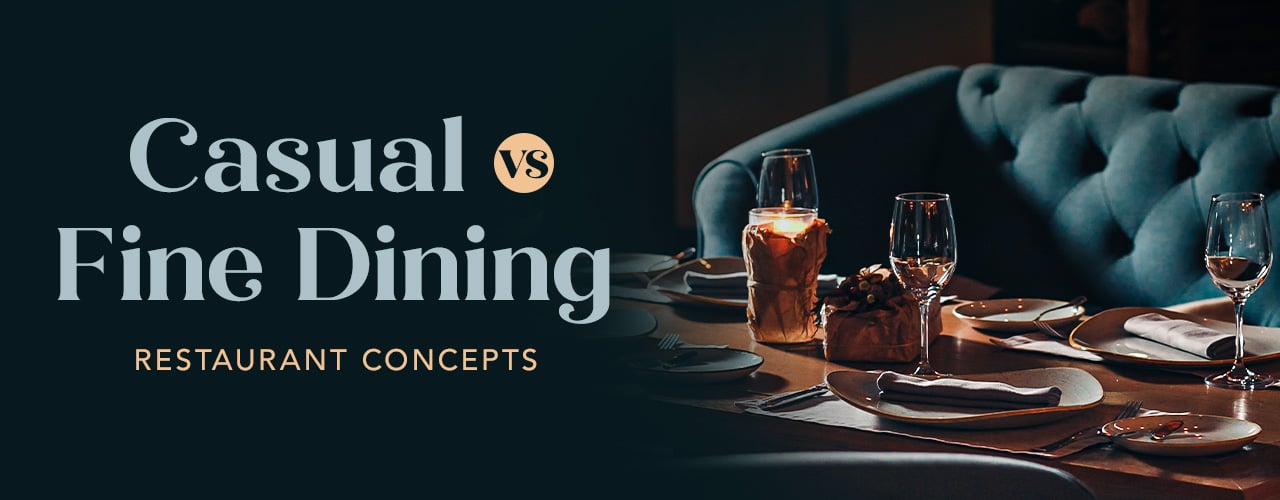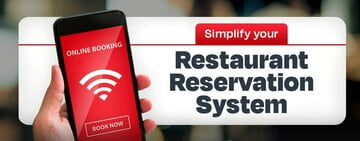
Casual and fine dining establishments are widespread and have unique benefits and appeal, but not every prospective business owner knows what they mean. If you are opening a restaurant, it is critical to choose the style of dining that best fits your vision. By understanding the distinctions between casual and fine dining, you can make an informed decision that aligns with your restaurant concept and target market. We'll outline both types below so that you can craft your dining experience.
What Is the Difference between Fine Dining and Casual Dining?
Fine and casual dining are two distinct categories within the restaurant industry. In general, the main differences between the two come down to ambiance, price, menu, and convenience. We'll outline each of these factors in detail below:
- Ambiance: Fine dining establishments feature upscale decor, elegant table settings, and a refined atmosphere. In contrast, casual restaurants have a more relaxed ambiance, often characterized by a laid-back setting, comfortable furnishings, and a welcoming feeling.
- Price: Most fine dining settings are known for their high prices, reflecting the quality of ingredients, skilled culinary techniques, and impeccable service that patrons can expect. Conversely, casual dining establishments offer more affordable menu options, making them more accessible.
- Menu: A fine dining concept typically offers a curated menu featuring gourmet dishes, innovative culinary creations, and artisanal ingredients. Casual dining menus tend to be more diverse, offering a mix of familiar comfort foods, classic dishes, and popular favorites that cater to a broader audience.
- Convenience: Fine dining establishments may have dress codes and require a more structured dining experience, while casual restaurants are more approachable and laid-back, allowing diners to drop in when they please and dress relaxed.
What Is Fine Dining?
When dining at a fine dining establishment, patrons can expect a formal experience steeped in elegance and attention to detail. Reservations are typically required in advance to secure a table, and there is a sense of exclusivity associated with them. To ensure the best dining experience, these restaurants hire specialized staff such as sommeliers, maitre d's, and highly trained chefs dedicated to delivering top-notch service. They often serve meticulously curated multi-course meals and are known for their luxurious ambiance.
How to Start a Fine Dining Restaurant

Fine dining customers have high expectations and anticipate a certain type of experience when dining at your establishment. As you plan out your restaurant and write your business plan, it is crucial to keep in mind that you are aiming to cultivate a high-end dining atmosphere. To meet the standards of fine dining, consider these factors:
- Pricing: When setting prices for your fine dining restaurant, strike a balance between offering upscale dishes and ensuring that your profit margin aligns with your goals. Conduct thorough market research to understand pricing trends and customer preferences in the fine dining segment.
- Location: Consider restaurant locations that align with the ambiance and clientele you wish to attract, such as upscale residential neighborhoods or vibrant city centers known for their high-end dining options.
- Equipment: Invest in high-quality kitchen appliances, culinary tools, and serving equipment to meet the expectations of your customers.
- Dinnerware: Impress your guests with exquisite dinnerware, glassware, and tableware. Opt for sophisticated and durable pieces that enhance the presentation of your culinary creations.
- Alcohol selection: Enhance the dining experience by offering a diverse and premium selection of wines, spirits, and cocktails. Create a well-curated wine list and cocktail menu that complements your menu.
- Layout: Pay attention to lighting, seating arrangements, and ambiance to create a welcoming and refined atmosphere that resonates with your target clientele.
What Is Casual Dining?
Casual restaurants typically serve moderately priced foods and offer a more traditional menu selection. These establishments are designed to be easily accessible to a wide range of guests, including families with children. Their atmosphere is laid-back and welcoming, making them ideal settings for informal gatherings and dining experiences. They employ a traditional restaurant staff, including servers, bartenders, and hosts, to cater to the needs of diners.
How to Start a Casual Dining Restaurant

Casual dining restaurants come in many forms and lend themselves to a host of creative concepts. However, because casual dining comes with a different set of expectations, there are specific factors to consider as you begin your restaurant venture.
- Menu: Casual dining restaurants can offer a wide range of foods, but they are typically easy to prepare or appeal to a broader audience.
- Pricing: When setting prices for your menu items, ensure that your foods are competitively priced to attract a larger demographic. Pricing plays a significant role in the success of a casual dining restaurant, and you don't want to price people out.
- Atmosphere: Embrace a laid-back, casual, and inviting atmosphere in your restaurant. The ambiance of your establishment plays a crucial role in attracting and retaining customers.
- Equipment: Investing in the right kitchen equipment is essential for the smooth operation of your casual dining restaurant. Most casual kitchens can get by with standard restaurant appliances and supplies.
- Dinnerware: While you don't need to purchase the fanciest products, investing in quality dinnerware, glassware, and tableware that match your restaurant's needs is essential. The presentation of your food and beverages can significantly impact the overall dining experience for your customers.
Back to Top
Both casual and fine dining have rich and interesting histories. Knowing what sets them apart allows business owners to make projections for the restaurant industry’s future and stay ahead of the curve. Ultimately, the success of your restaurant, no matter the type, hinges on knowing and satisfying your customers' wants and needs.





